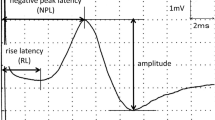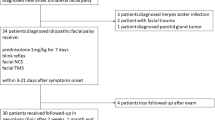Abstract
We report our results from the application of evoked electromyography (EEMG) and facial nerve latency testing (FNLT) in 30 children aged 4–14 years with idiopathic facial palsy. Our aim was to define the value of these tests as prognostic tools in Bell's palsy. From the EEMG results we ascertained that, when the amplitude of the compound muscle action potential varied between 51% and 95% of the normal value, the neuronal damage is slight (neurapraxia). When the percentage value of muscle response decreases, the prognosis is worse. The results of the FNLT showed that, when the latency is within normal limits, the damage to the nerve is slight (neurapraxia). If the latency is prolonged, the prognosis is worse. Evaluation of our results and comparison with the index of facial nerve functional recovery showed that those two tests have a high percentage of correctness (100% for the EEMG and 96.7% for the FNLT) and a low percentage of error. We conclude that these tests are excellent for predicting the outcome of facial nerve palsy in childhood and we suggest that young patents undergo both so that the determination of the lesion may be as correct as possible.
Similar content being viewed by others
References
Danielides V (1990) The contribution of electrical tests in evaluation and location of damage of the facial nerve. Doctoral thesis, Ioannina, Greece
Danielides V, Skevas A, et al (1992) Value of the facial nerve latency test in the prognosis of childhood Bell's palsy. Child's Nerv Syst 8:126–128
Fisch U, Esslen E (1972) Total intratemporal exposure of the facial nerve. Arch Otolaryngol 95:33
House JW (1983) Facial nerve grading system. Laryngoscope 93:1056–1069
Joachims HZ, et al (1980) Early diagnosis in Bell's palsy. Laryngoscope 90: 1705–1708
May M (1986) The facial nerve. Thieme, Stuttgart, pp 244–252
Skevas A, Danielides V, Assimakopoulos D (1990) The role of the facial nerve latency test in prognosis of Bell's palsy. Laryngoscope 100:1083–1085
Sunderland S (1978) Nerve and nerve injuries, 2nd edn. Churchill-Livingstone. London, pp 88–89, 96–97, 133
Waylonis GW, Jonson EW (1964) Facial nerve conduction delay. Arch Phys Med Rehab 45:539
Author information
Authors and Affiliations
Rights and permissions
About this article
Cite this article
Danielides, V., Skevas, A., Kastanioudakis, I. et al. Comparative study of evoked electromyography and facial nerve latency test in the prognosis of idiopathic facial nerve palsy in childhood. Child's Nerv Syst 10, 122–125 (1994). https://doi.org/10.1007/BF00302776
Received:
Issue Date:
DOI: https://doi.org/10.1007/BF00302776




